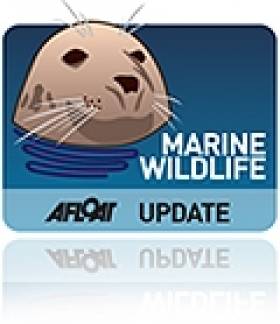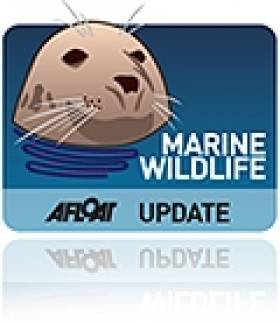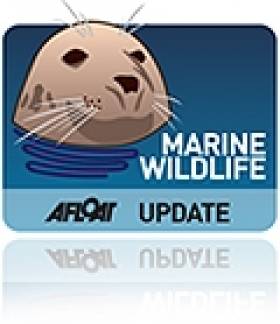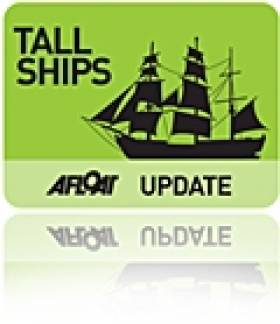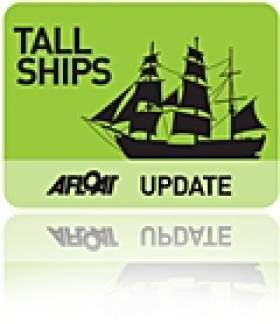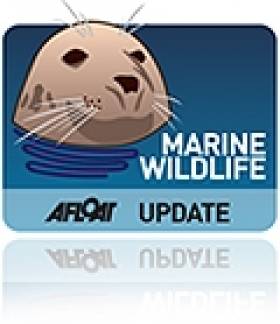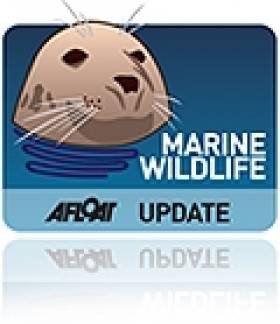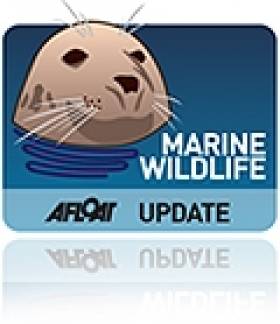Displaying items by tag: IWDG
Plans to Sink Baltimore Whale Carcass and Retrieve Its Skeleton
#MARINE WILDLIFE - Plans are afoot to sink the carcass of the fin whale that died after being trapped in Baltimore Harbour last week, according to the Irish Independent.
It is being proposed that the whale's body can be wrapped in netting and sunk using old train wheels as weights.
"We're looking at putting it in the water and letting it sink to the seabed where the fish and crabs can do their work and strip the flesh from the carcass," said local diver Jerry Smith. "The end scenario would be to retrieve the skeleton from the sea bed."
It's hoped that the skeleton of the 65ft female juvenile fin whale could eventually be put on display as an educational aid and a tourist attraction for the West Cork town.
Cork County Council has taken responsibility for the disposal, as the Cork Independent reports, and the 30-tonne marine giant has already been towed to Oldcourt in the Ilen esturary.
As previously reported on Afloat.ie, calls have been made to introduce a new protocol to deal with large marine wildlife strandings.
The Irish Whale and Dolphin Group (IWDG) defended itself from criticism over the handing of the "unprecedented" incident, arguing that allowing the whale to die was the best option available under the circumstances.
The Irish Independent has more on the story HERE.
Call for Whale Stranding Protocol After Baltimore Incident
#MARINE WILDLIFE - The Cork News reports that a new protocol will be introduced to deal with large marine wildlife strandings following the public backlash over the handling of the injured and malnourished fin whale in Baltimore Harbour this week.
The 30-tonne whale died on Thursday morning after being trapped in the harbour on Tuesday. As previously reported on Afloat.ie, the whale was left to die as it was found to be too ill to be assisted back into deeper water and was too large to be euthanised with drugs.
Members of the public have complained about the 'do nothing' approach taken by experts. But Dr Simon Berrow of the Irish Whale and Dolphin Group (IWDG) defended his organisation's handling of the affair, citing the lack of protocol for such an unforseen incident.
"We are recognised as the most confident group in Ireand in dealing with dolphins and whales but as a charity, it should not be our responsibility," he said. "I don't have the authority to tell someone to shoot a whale."
Dr Berrow said he had been in talks with the Defence Forces about arranging for the distressed whale to be shot before it died, most likely from wounds sustained on sharp rocks in the harbour.
Speaking with The Irish Times, the IWDG's Padraig Whooley said: "As humans, we always think we have to intervene but wildlife rarely does better when we do. In this particular case the ‘do nothing’ approach was the only option open to us."
Whooley also criticised the "fairly shocking" level of ignorance over the incident that saw crowds continue to gather at the harbour in Baltimore even after it became clear that the whale was in significant disgress.
'Nothing Can Be Done' for Stranded Whale in Baltimore Harbour
#BALTIMORE WHALE - Hopes are fading for an injured whale trapped in Baltimore Harbour, according to the Irish Independent.
It's being reported that the fin whale, which was injured on sharp rocks and beached off the pier in the West Cork harbour yesterday, is being left to die as it is too ill to be helped back to deeper water and too large to be euthanised.
It had been hoped that the whale would return to the sea under its own power by high tide but that sadly did not happen.
"Nothing can be done," Dr Simon Berrow of the Irish Whale and Dolphin Group (IWDG) told the Independent. "It can't be refloated or drigged. All you can do is let nature take its course."
The 40-foot whale became something of an instant attraction in Baltimore as crowds gathered in the harbour, as TheJournal.ie reports.
However, marine wildlife experts believe that the young whale must have been sick or malnourished to have made it so far from the open sea into the sheltered harbour.
The IWDG's Padraig Whooley also reiterated that most whale strandings end in death, and Brendan Cottrell of the Baltimore RNLI said the best thing was to do their best not to stress the animal further.
Elsewhere, a female fin whale stranded on a beach in Cornwall has died despite efforts to save her, according to the Daily Mail.
The 65-foot whale was put down by vets from British Divers Marine Life Rescue after she was found beached at Carylon Bay on the south coast on Monday morning. The whale was was described as "incredibly undernourised".
Wait Almost Over for Celtic Mist Relaunch
#CELTIC MIST - The wait is almost over for the relaunch of the Celtic Mist, as The Irish Times reports on the completion of its 'make-under'.
Tomorrow 12 August will see the ketch formerly sailed by late Taoiseach Charles Haughey officially begin its new life as a research vessel for the Irish Whale and Dolphin Group (IWDG), as previously reported on Afloat.ie.
Apart from extensive work to the interior of the vessel to transform crew accommodation and make space for scientific instruments, the hull of the Celtic Mist has been beautifully repainted in different shades of blue, with details such as a dolphin on its bow and a fun whale along the beam contributed by Kerry artist Michael O'Leary.
Among the new gizmos installed on the yacht - which sailed a leg of last year's Tall Ships Races - is an automatic identification system that will allow internet users to track its position online.
Conor Haughey, whose family gifted the yacht to the IWDG for its marine wildlife conservation work, is expected to attend the relaunch ceremony at Kilrush marina at 2pm, hosted by Afloat.ie's own Tom MacSweeney with a blessing by Fr Michael Sheedy of Kilrush.
Celtic Mist Almost Ready for Relaunch Next Month
#CELTIC MIST - The Irish Whale and Dolphin Group's (IWDG) new research vessel is finally set for its official launch three weeks from this coming Sunday.
As previously reported on Afloat.ie, Celtic Mist - the yacht formerly sailed by late Taoiseach Charles Haughey - was gifted by the Haughey family to the IWDG to assist in its marine wildlife conservation work.
The boat relocated to its new home berth in the Shannon Estuary at Kilrush, Co Clare in July last year - after one last hurrah in its former guise by completing a leg of last summer's Tall Ships Races from Waterford to Greenock in Scotland.
Celtic Mist entered dry dock last November for its necessary refit as a maritime research vessel, while the IWDG sought funding to complete the more than €60,000 project.
With a year gone by since the IWDG first took over the yacht, she is finally back on the water and undergoing the last few finishing touches before her first mission - which may involve tracking the elusive blue whale in Irish waters.
Internally, she is a very different vessel to the one that Charles Haughey sailed, with the aft cabin stropped out and replaced by berths for skipper and crew.
According to IWDG co-ordinator Dr Simon Berrow, there is also "a science area where towed and dipping hydrophones and environmental logging software will be run."
The engine room, meanwhile, has been "completely cleaned out and painted including opening and de-greasing of the fuel tanks".
Berrow adds that there is "still considerable work to be done", explaining that the masts and rigging require inspection, aside from all the "painting, sanding, varnishing and more painting to be completed".
The plumbling and electrics also need to be finished, but Berrow says the refitting team is "making rapid progress".
All are welcome to the official launch of the Celtic Mist on Sunday 12 August at 2pm at Kilrush Creek Marina in Co Clare. For more details visit the yacht's official website at www.rvcelticmist.ie.
Haughey Yacht Nearly Ready for New Life as Research Vessel
#TALL SHIPS - Celtic Mist - the yacht once owned by the late former Taoiseach Charles Haughey - will soon take to the waves in its new guise as a research vessel as its refit nears completion, today's Sunday Independent reports.
As reported last year on Afloat.ie, the 52-foot yacht was gifted by the Haughey family to the Irish Whale and Dolphin Group (IWDG) to assist in its marine wildlife conservation work.
After completing a leg of the Tall Ships Races from Waterford to Greenock in Scotland, the boat sailed to its new birth at Kilrush in Co Clare last July while the group raised the necessary funds to enter dry dock for refurbishments and refitting as a marine research vessel.
By January of this year the IWDG had reached 75% of the more than €60,000 required to complete the work, which involved stripping out the main cabin to increase space for equipment and crew berths.
"We are finishing off the renovations at the moment and we're hoping to have it back on the water in the next few weeks," said the IWDG's Simon Berrow. "We estimate it will cost around €80,000 by the time it is finished."
The refurbished yacht includes a fitting tribute to its previous owner in the form of a clock over his former cabin with a photo of Haughey in his skipper's cap on the background.
Berrow also hailed Haughey's love of the sea, which prompted his declaration of Irish waters as a whale and dolphin sanctuary.
The IWDG will use the Celtic Mist to train and teach its members how to survey and record whales and dolphins. As well as research projects, it will be used for educating schoolchildren about marine conservation and the abundant life in Ireland's coastal waters.
It is also hoped that President Michael D Higgins - who became patron of the IWDG in February - will be on hand to officially launch the vessel this August.
The Sunday Independent has more on the story HERE.
#MARINE WILDLIFE - The Irish Whale and Dolphin Group (IWDG) has called for the extension of Ireland's pioneering whale and dolphin sanctuary throughout European coastal waters.
As the Clare Herald reports, the move comes on the 21st anniversary of the declaration of Irish waters as a sanctuary for cetaceans by then Taoiseach Charles Haughey - whose family gifted his yacht Celtic Mist to the IWDG to assist in its marine wildlife conservation work.
"The sanctuary declaration was unique in Europe and no EU member state had made such an unequivocal statement about the importance of their waters for cetaceans," said the IWDG's Brendan Price.
The sanctuary extends up to 200 nautical miles offshore, covering the Irish Exclusive Economic Zone, and in the two decades since its founding has prompted a greater awareness of and interest in the whales and dolphins that populate Ireland's waters.
The declaration "led to a clearer understanding of the responsibility Ireland had to cetaceans and their habitat including in offshore waters," added Price. "The sanctuary declaration was a precursor to action leading to protection in Irish waters and thus the IWDG considers the sanctuary declaration a success."
Price went on to outline the IWDG's vision for extending this sanctuary throughout European waters.
"There are a number of small marine protected areas in Europe for cetaceans, including harbour porpoise and bottlenose dolphins, and some international sanctuaries such as the Pelagos Sanctuary in the Mediterranean.
"These areas all have important roles to play but cetaceans are mobile marine species and travel large distances. Also, to gain public support for cetacean conservation it may require a larger, more simple concept."
The group intends to promote its proposals within the continent "and encourage like-minded people and organisations to lobby their own government to make such a clear and unequivocal statement on cetacean conservation".
#MARINE WILDLIFE - The Department of Energy could be in beach of the EU habitats directive for licensing a seismic survey off the West coast without providing adequate protection for marine wildlife.
As The Irish Times reports, the Irish Whale and Dolphin Group (IWDG) has lodged a complaint with the European Commission and the Department of Energy over the survey licence.
Shell E&P Ireland Limited is scheduled to carry out the 3D seismic survey over the Corrib Gas Field off Co Mayo from today 1 June, as previously reported on Afloat.ie. Weather permitting, the survey would be completed around the middle of September.
The waters around Ireland are designated as a whale and dolphin sanctuary. According to the IWDG, 21 cetacean species have been recorded off the Mayo coast, including endangered species such as the northern right whale, fin whale and humpback whale.
Under the EU habitats directive, member states are mandated to establish strict protections for marine wildlife, which includes prohibiting “deliberate disturbance... particularly during the period of breeding, rearing, hibernation and migration”.
The Irish Times has more on the story HERE.
#MARINE WILDLIFE - Another humpback whale sighting off West Cork has been confirmed by the Irish Whale and Dolphin Group (IWDG) - and it could be a new arrival to these shores.
The humpback was encountered some seven miles southeast of Galley Head near Clonakilty Bay on Wednesday 16 May by local whale watch operator Colin Barnes.
A tell-tale series of three blows and a tail fluke were enough for Barnes to confirm the species, but unfortunately its identity could not be confirmed, which means it could be a newcomer to Irish waters or one of two humpbacks sighted in the same area in earl April, as previously reported on Afloat.ie.
"If it is a new animal, this will bring to 21 the number of recognisable humpbacks recorded to date in Irish waters," said IWDG sightings co-ordinator Pádraig Whooley, who noted with interest that while the group is concluding its field work in the seasonal feeding grounds around Cape Verde, there are "also humpbacks present at higher latitude feeding grounds".
Whooley commented at the time of the April sightings: "Why these two young humpbacks are here during spring, when years of data shows them to be absent in these months, is a mystery."
The IWDG has more on the story HERE.
#MARINE WILDLIFE - The East Coast of Ireland was treated to a rare sight yesterday morning with the spotting of a basking shark at Dun Laoghaire.
According to the Irish Whale and Dolphin Group (IWDG), the gentle giant was sighted by Ronan McLaughlin of the Naval Service vessel LE Ciara at the entrance to Dun Laoghaire Harbour - which may allow for the perfect opportunity to easily observe the visitor.
IWDG sightings co-ordinator Pádraig Whooley said: "So far 2012 has been another very good year for sightings of this 'honorary whale', with 78 validated sightings to date, almost all of which have come from the south and west coasts."
He added: "In recent years only between 1-5% of all basking shark sightings have been off the Irish East Coast, which is at odds with the fact that [the] nearby Isle of Man is considered to be one of the best sites to observe the planet’s second biggest shark species."
Basking sharks are protected under EU law, which makes it illegal to disturb or harass them.
As previously reported on Afloat.ie, the UK's Shark Trust has published a code of conduct for anyone encountering basking sharks in British or Irish waters this summer.



























